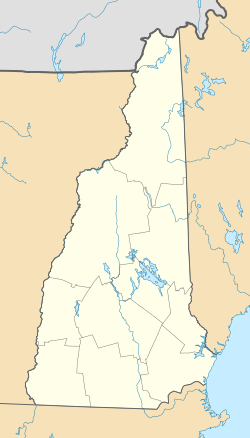Harrisville Historic District (Harrisville, New Hampshire) facts for kids
|
Harrisville Historic District
|
|

Cheshire Mills, 1969
|
|
| Location | Harrisville, New Hampshire and vicinity |
|---|---|
| Architect | Multiple |
| MPS | Harrisville MRA (AD) |
| NRHP reference No. | 71000072 |
Quick facts for kids Significant dates |
|
| Added to NRHP | September 17, 1971 |
| Designated NHLD | December 22, 1977 |
The Harrisville Historic District is a special place in New Hampshire. It's a very old and well-kept mill village in the southwest part of the state. A mill village is a community built around factories that use water power to make things, like cloth.
This historic area covers about 200 acres (that's about 800,000 square meters) and has around 135 buildings. Because it's so important and well-preserved, it was named a National Historic Landmark in 1977. This means it's a place recognized by the United States government for its amazing history.
You can find the district about 10 miles (16 kilometers) east of Keene, New Hampshire. From there, you travel 3 miles (5 kilometers) north on Harrisville-Dublin Road, just off New Hampshire Route 101.
Contents
Discovering Harrisville's Past
The land where Harrisville stands today was once part of the towns of Dublin and Nelson. This area is quite hilly, sitting on a ridge about 1,300 feet (396 meters) above sea level. This ridge divides the Connecticut River and Merrimack River watersheds.
The Very First Mills
In 1774, a man named Abel Twitchel built the first mills here. He created a gristmill (for grinding grain into flour) and a saw mill (for cutting wood). These mills were powered by a stream running through the village.
Later, Jason Harris opened a blacksmith shop. For a while, the village was known as Twitchell's Mills, named after Abel. This changed around 1830.
In 1799, Jonas Clark built a mill to make clothing. His mill was used for fulling (making cloth thicker) and dressing (finishing) fabric. His wife also spun (made into thread) linen there. The Clarks sold their mill in 1804 and moved away.
Early Innovations in Wool
Around this time, Bethuel Harris and Abel Twitchell added a wool carding machine to Clark's old grist mill. A carding machine helps prepare wool fibers for spinning. It's said that this was only the second machine of its kind in the entire United States!
In 1822, Bethuel and Cyrus Harris built a new brick mill. They used it to make woolen cloths. Milan Harris, another family member, installed the machinery in this mill.
The Famous Harris and Cheshire Mills
In 1833, Milan Harris and A.S. Hutchinson built another new mill. This one was called the "Upper Mill." Today, it's known as the Harris Mill. This mill is now owned by Historic Harrisville, Inc. It's home to Harrisville Designs, a company started in 1971 to help keep the history of wool making alive in the village.
Cheshire Mill No. 1 is another important building. It was built in 1848 by Cyrus Harris using strong New Hampshire granite. You can spot it by its unique bell tower. This mill was one of the last textile mills still working in New England, finally closing in 1970.
The site also includes Cheshire Mill No. 2, a red brick building from 1859. Later, Cheshire Mills No. 3, 4, and 5 were built in the early 1900s.
A Complete Historic Village
The Harrisville Historic District isn't just about mills. It also includes many old homes and cottages where the mill workers lived. You'll find several churches, a storehouse, a general store, and even a cemetery. All these buildings together show what life was like in a busy New England mill village long ago.




